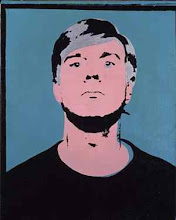 |
| Peter Halley, Auto Zone, 1992 |
Last year Tate Modern presented a fascinating show of the work of Kazimir Malevich, creator of the revolutionary Black Square in 1915 (see below). Now Whitechapel Gallery is showing an ambitious exploration of the story of abstraction as it evolved through the following 100 years in the work of some 100 artists.
The exhibition follows 4 themes: Utopia, Architectonics, Communication, and the Everyday and charts the life of geometric abstraction through painting, sculpture, photography, graphic design and textiles, from Russia to the USA, from Europe to Asia and Latin America, from revolutionary politics to corporate capitalism, from the spiritual to the material. It promises to be a rich and fascinating story. (I was fascinated to learn from Adrian Searle's review that Amalia Pica's Memorial for intersections #2 (see image, below) refers to the banning of the use of Venn Diagrams in primary schools in Argentina in the 1970s - on the grounds that they were believed to encourage subversive thought!?)
Read reviews by Adrian Searle, Laura Cumming, Waldemar Januszczak, Jackie Wullschlager, J J Charlesworth, Louisa Buck and Charley Peters and an article by Frances Spalding. See also, below, for information about the complementary exhibition: David Batchelor: Monochrome Archive, 1997-2015.
 |
| Kazimir Malevich, Black and White Suprematist Composition, 1915 |
 |
|
El Lissitzky,
Beat the Whites with the Red Wedge!, 1919–1920
|
 |
| Aleksandr Rodchenko, Radio Station Tower, 1929 |
 |
|
Piet Mondrian, Composition with Yellow, Blue and Red, 1937 |
 |
|
Hélio Oititica, Metaesquema 464,
1958 |
 |
| Josef Albers, Homage to the Square: Post Autumn,1963 |
 |
| Dan Flavin, Monument for V. Tatlin, 1966 |
 |
| Carl Andre, 10 x 10 Altstadt Lead Square, 1967 |
 |
|
Daniel Buren, Seven Ballets in Manhattan, 1975 (To be restaged in London during the course of the exhibition.) |
 |
| Jenny Holzer, Top Secret 32, 2010 |
 |
| Rosemarie Trockel, Cogito, erg sum, 1988 |
 |
| Amalia Pica, Memorial for intersections #2, 2013 |


No comments:
Post a Comment